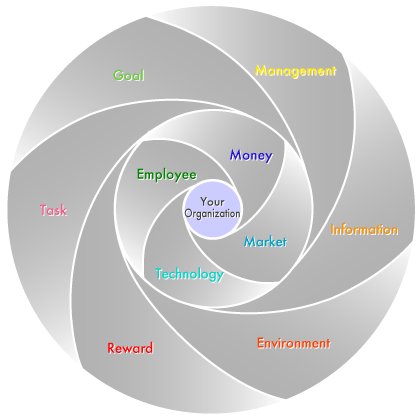IIOSS SeiJuku™ Organizational Model
Every organization consists of (a) members or people who have (b) tasks to do. That is the backbone of multinational, multi-billion dollar corporations and that is the backbone of the smallest, mama-papa store.
The members and the tasks are just the tip of the iceberg called an organization. Underneath of these top components lie another factors.
IIOSS defines the organization as a system of ten entities: employee, task, environment, management, goal, reward, market, technology, money, and information. When you think about each entity like the employee or management, you begin to notice how each entity correlates to each other, constructing a very complex system.
- The employees influence their environment and are under influence of that environment.
- The employees set goals to be achieved.
- The employees get rewards for doing their tasks and achieving the goals.
- The tasks are driven by the market needs.
- The tasks are carried out using some technology.
- Doing the tasks requires money.
- Doing the tasks generates different information.

As described above, IIOSS Theory explains every organization by 10 entities, their characteristics (called attributes) and relationships between them.
Every change in the attributes or relationships results in change in all entities. That makes the organizations dynamic systems. The change in attributes and relationship defines the ways how organizations grow or develop and that is explained in the SeiJuku Lifecycle model of Growth.
In many cases, the management is the driving force for an organization to grow and it is the main reason for organizational decline. Thus, the basic managerial task is to find all disharmonies in the organization and 和 (harmonize) wa them as much as possible. This is a continuous task since the organizations change throughout their life span.

